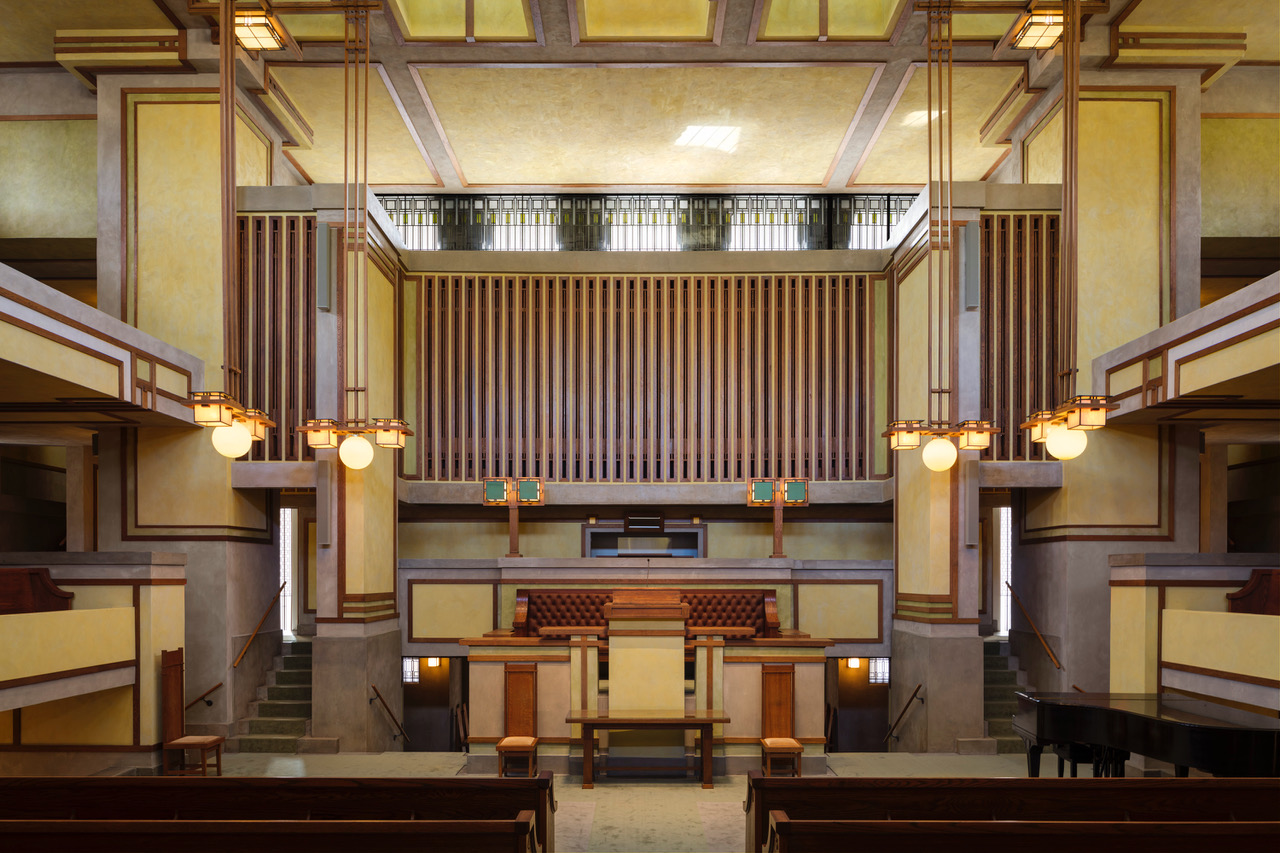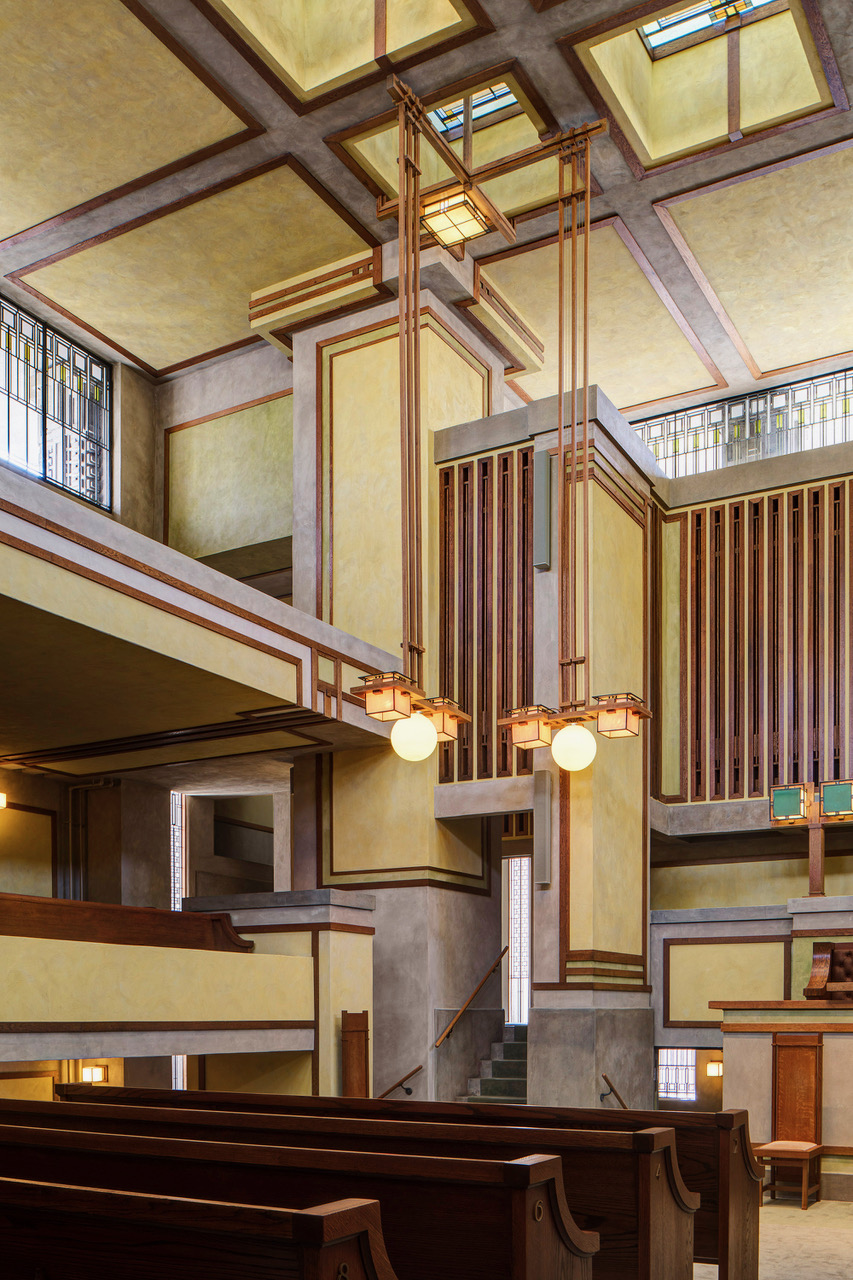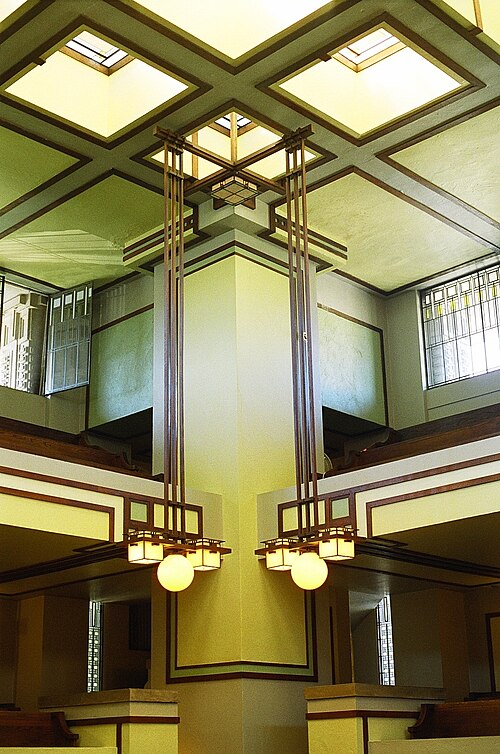By Judy Carmack Bross

Unity Temple Auditorium, photo by Tom Rossiter
Frank Lloyd Wright called it “my little jewelry box.” Critics described it as “the concrete bunker on Lake Street.”
For architect Gunny Harboe, an internationally recognized preservationist who has led projects on major landmarks such as the Reliance Building, the Chicago Cultural Center, the Charnley-Persky House, Lake Forest Station and both of Wright's Taliesin buildings, Frank Lloyd Wright's Unity Temple in Oak Park was a restoration project he embarked on 25 years ago that he always found fascinating or challenging.

Gunny Harboe speaks at Unity Temple.
Interested in architecture and history, organized by his friend Grove Mower, through the Unitarian Universalist Church, commonly known as Unity Temple, which since its opening in 1908 has had the ongoing mission: “For the worship of God and the service of man.” As he spoke of the gentle reflection of light from all the original lights, now reinstalled, and the purposeful feeling of anticipation as one walks from the auditorium into the towering sacred space, we wanted to encourage you to return or visit for the first time.

Photo by Tom Rossiter
Harboe said: “Wright was undoubtedly the most important American architect of the last century. He built the Unity Temple when he was just 39 years old and at the early height of his career.” He had visited Japan in 1905 and seen Shinto temples, which influenced his work on this project. Wright came from a family of Welsh Unitarians and was proud to have won the competition. Immediately afterward, he built the Robie House and in 1910 he left his family and moved from Oak Park.
It is one of eight Wright structures designated a UNESCO World Heritage Site in the United States. The total of 26 other cultural sites include Monticello, the Statue of Liberty and Independence Hall. Originally it was supposed to be made of bricks, but the church didn't have enough money so they saved money by making it out of concrete. According to Harboe, “Wright wanted it to look like it had been carved from granite. Unfortunately, he didn't really understand all of the properties of concrete as a building material.”
Harboe said that in 2000, engineers were brought in to work on the defective concrete overhangs and he was asked to join the team to address the aesthetic issues associated with the concrete adjustment. He led the restoration of several of Wright's buildings and frequently writes and speaks about his architecture.
In 2006, the staff of Harboe Architects, then working for Austin/AECOM, completed a restoration master plan for the Unity Temple. The plan included a comprehensive analysis of the building and its systems, an assessment of accessibility issues with recommended improvements, and a schematic scope of work for restoring the structure to its 1908 condition. A further in-depth feasibility study was conducted in 2014 by Harboe Architects to fully understand the scope and costs required to fully restore the Unity Temple, including comprehensive surveys and modeling for proposed treatments of all interior and exterior surfaces.
There were two entities overseeing the site: the Unitarian Universalist Congregation of Unity Temple, which owned and used the building, and the Unity Temple Restoration Foundation, which was established to restore the building to its original beauty. “In 2005, the master plan was to raise over $20 million,” Harboe said. A generous donation from the Alphawood Foundation enabled the project to continue.
Wright's concept for the building was to create a space for both the sacred and the secular. This concept evolved into two separate masses, each housing the temple or sacred space and the Unity House, a space for meetings and classrooms. These two main volumes form the main rooms of the building and are connected in the middle by the foyer. The result was a bold and innovative design that was conceptually rooted in the Prairie School period while anticipating the modern architectural movement then burgeoning in Europe.

Photo by Tom Rossiter
In 2009, the shotcrete surfaces applied in the 1970s appeared to have cracks everywhere, and several of the 22 roofs were leaking. It took months to match the color of the shotcrete, which comes in a surprising range of shades from gray to brown. The stock consisted of sand, pea gravel and flint pebbles, which had to be purchased specifically for the mixture. Normally a historic building should never be sandblasted, but in this case the existing shotcrete was refinished in the 1970s.
“The wood paneling is what makes the room resonate. Wright was a master at using wood paneling to break up the space,” Harboe said. During the work, the restoration carpenters found a piece of molding with an autograph from one of the original carpenters from 1908. In another coincidence, the son of a man who repaired the exterior with shotcrete in the 1970s was working on the most recent project.
All light fixtures and art glass windows had to be sent to the studios of an art glass expert in California, where they were restored, then sent back and reinstalled.

Original Wright lights at Unity Temple.
For guests visiting the Unity Temple at dusk that evening, the glass certainly retained the luster Wright had hoped for.
We were curious to see how Oak Park residents view this World Heritage Site in their downtown, so we asked art educator and good friend Joe Berton. Berton taught middle school art in Oak Park for 34 years. He is married to Gloria Groom, Chair of European Painting and Sculpture at the Art Institute. They live in Oak Park.
I have lived in Oak Park since 1977. I was hired right out of college to teach Applied Arts, Art with a Purpose or Function, to twelve and thirteen year olds at one of our two middle schools. Of course, this course included architecture, and since I was in Oak Park, I wanted to include the work of local favorite Frank Lloyd Wright. In the late 1970s, most Oak Park residents had not given architectural preservation any thought. There was a change in neighborhoods and integration. School boundaries were redrawn to accommodate the new middle grades. Some Wright houses were in dire need of repairs. A teacher colleague of mine rented a room at the Wright Home and Studio, where restoration was beginning in earnest.
My students and I took walking tours from the Wright Home and Studio on Chicago Avenue, across Forest Avenue to see other Wright-designed homes, to Lake Street, where the Unity Temple is located. For my students, it was a walk in a familiar neighborhood. They had friends who lived in some of these houses. The contrasts between the large Victorian homes and the striking prairie landscape examples were striking. Wright's use of local materials, the strong horizontals, and the hidden entrances could be seen and studied from the outside, but the Unity Temple had to be seen from the inside. Little did one know what wonders they would discover inside these two rather impressive gray cast concrete boxes. Inside, the children were always amazed, truly overwhelmed. The sheer beauty of the worship space always silenced the group of young people. They became quietly thoughtful.
And now the Unity Temple has completed its restoration. Wright called it a “noble room.” That's actually it. Gloria and I love sharing the same student walk with our frequent out-of-town guests, which takes them from the Wright Home and Studio across Forest Avenue and ends at Unity Temple. You'll even learn the backstory of where some of my former students lived. And a couple from our church choir lives in this Wright house. And that's where you live as a strong supporter of art in public school. And here at Unity Temple, some of our friends attend the service. This area is full of true architectural gems, each one carefully cared for and preserved. The buildings and the people who inhabit them are an integral part of a functioning and pleasant neighborhood.